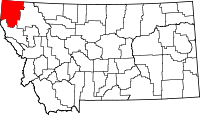Swan Valley Massacre of 1908
The Swan Valley Massacre was an incident in 1908 in which a hunting party of four Pend d'Oreilles Indians were killed by a state game warden and his deputy in the Swan Valley in Northwestern Montana. This confrontation was due in part to the state of Montana not honoring off-reservation hunting permits. There was miscommunication between the Pend d'Oreilles and the game warden regarding their right to hunt outside reservation boundaries.
Background
The Bitterroot Salish (Flathead) and Pend d’Oreilles (Kalispel) tribes of the Northern Rocky Mountain (Plateau) region of the Western United States had occupied, and hunted and gathered in the area around Flathead Lake. The Salish were known to war with the Blackfeet and Shoshone. With the rise of the fur trade in the late eighteenth century, many Salish and Pend d’Oreilles became involved as trappers and traders. The Salish were visited by the Lewis and Clark expedition in 1805 in which they traded gifts of goods and horses.
The Jesuits, Catholic missionaries, came to live among the Salish in the Bitterroot Valley in the early 19th century with the intent of converting the natives; they started by building a church. During the Steven’s Treaty era, Washington Territory Governor Isaac Stevens called the Salish, Pend d’Oreilles, and Ksanka Band of Kootenai together in 1855 to negotiate the Hellgate Treaty. This treaty with the U.S. Government established a reservation and a peaceful confederation of these tribes.
Altercation
According to the 1855 treaty, the confederated tribes retained the right to hunt, gather, and fish in their aboriginal territory, some of which was outside the reservation boundaries. This practice came into conflict with the state law after Montana acquired statehood in 1889. It established its own hunting and fishing regulations to be enforced by game wardens. Only the federal government had jurisdiction within reservation borders, but in other parts of the state, officials believed they had authority to regulate Native Americans as well as non-Native Americans.
In September 1908 a party of eight Pend d’Oreilles entered the ancient hunting grounds of the Swan Valley on the eastern side of the Mission Mountain range. The party members included Atwen Scwi, his wife, son, and daughter; Little Camille Paul and his wife who was pregnant; and two elders, Mary and her husband Martin Yellow Mountain. Before they had left the reservation, they purchased state hunting permits to avoid trouble, although this was not required under the Hellgate Treaty. (Yellow Mountain cleared permission for the expedition from the agent in Arlee).
In October, after they had camped for several weeks, Charles Peyton, a state game warden, together with a few deputized residents of the valley, entered the encampment three times to investigate the hunting party. He demanded hunting licenses and harassed the band. Peyton returned the next day with guns drawn, and demanded that the Pend d'Oreilles leave by the next morning. To avoid confrontation, the band decided to move and began to pack up the camp.
Escalation
The next day, before they could pack and mount their horses to leave (they had been delayed by two of their horses wandering through an open gate and having to retrieve them) Peyton arrived along with his deputy firing his gun.
He shot Camille Paul and Atwen, the two leaders of the party, who were unable to reach their guns. When Yellow Mountain tried to reach his weapon, Peyton shot him as well. As the women fled toward the edge of the clearing, Peyton chased them. Atwen’s son Peh-lah-so-weh found a gun and shot Peyton, hitting him in the stomach. The warden’s deputy Herman Rudolph shot Peh-lah-so-weh at the same time, killing him almost instantly.
As the women tended to the dead and dying members of the party, Peyton began to get back up. Camille’s wife, Clarice, fearful that Peyton would try to kill the rest of them, pulled her husband's rifle from under his body and shot twice at Peyton, leaving him dead.
Though six months pregnant, Clarice rode to another Pend d’Oreilles camp to seek help. When she arrived, the band of Many Names (Louie Mollman) took her in and tended to her. When Many Names’ party returned the next day to recover the bodies, they encountered a non-Indian posse. Many Names warriors restrained from attack.
Aftermath
Rudolph was scheduled for a county coroner’s appearance but left the area and was never prosecuted. The Pend d'Oreilles reinterred the bodies at the St. Ignatius Catholic cemetery.
Clarice gave birth to her son John Peter Paul. He told the story of his mother and their band for years. The tribe cut back on hunting parties outside the reservation for fear of similar attacks.
References
- Salish and Pend d'Oreille Culture Committee.The Swan Valley Massacre of 1908- A Brief History.
- John Fahey.The Flathead Indians.
- Theresa DeLeane O'Nell, Disciplined Hearts: History, Identity, and Depression in an American Indian Community (Berkeley, CA: University of California Press, 1996).
External links
- "We will never forget", Daily Inter Lake
.jpg)
